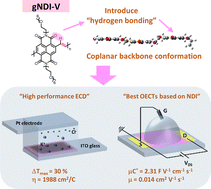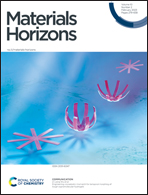Backbone coplanarity manipulation via hydrogen bonding to boost the n-type performance of polymeric mixed conductors operating in aqueous electrolyte†
Abstract
The development of high-performance n-type semiconducting polymers remains a significant challenge. Reported here is the construction of a coplanar backbone via intramolecular hydrogen bonds to dramatically enhance the performance of n-type polymeric mixed conductors operating in aqueous electrolyte. Specifically, glycolated naphthalene tetracarboxylicdiimide (gNDI) couples with vinylene and thiophene to give gNDI-V and gNDI-T, respectively. The hydrogen bonding functionalities are fused to the backbone to ensure a more coplanar backbone and much tighter π–π stacking of gNDI-V than gNDI-T, which is evidenced by density functional theory simulations and grazing-incidence wide-angle X-ray scattering. Importantly, these copolymers are fabricated as the active layer of the aqueous-based electrochromic devices and organic electrochemical transistors (OECTs). gNDI-V exhibits a larger electrochromic contrast (ΔT = 30%) and a higher coloration efficiency (1988 cm2 C−1) than gNDI-T owing to its more efficient ionic–electronic coupling. Moreover, gNDI-V gives the highest electron mobility (0.014 cm2 V−1 s−1) and μC* (2.31 FV−1 cm−1 s−1) reported to date for NDI-based copolymers in OECTs, attributed to the improved thin-film crystallinity and molecular packing promoted by hydrogen bonds. Overall, this work marks a remarkable advance in the n-type polymeric mixed conductors and the hydrogen bond functionalization strategy opens up an avenue to access desirable performance metrics for aqueous-based electrochemical devices.



 Please wait while we load your content...
Please wait while we load your content...